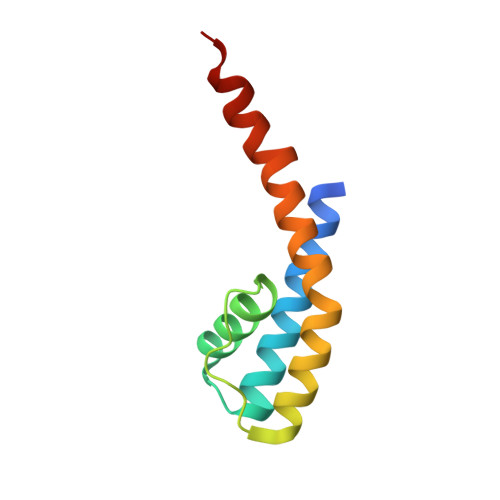Structural implications of weak Ca2+ block in Drosophila cyclic nucleotide-gated channels.
Lam, Y.L., Zeng, W., Derebe, M.G., Jiang, Y.(2015) J Gen Physiol 146: 255-263
- PubMed: 26283200
- DOI: https://doi.org/10.1085/jgp.201511431
- Primary Citation of Related Structures:
4ZBM - PubMed Abstract:
Calcium permeability and the concomitant calcium block of monovalent ion current ("Ca(2+) block") are properties of cyclic nucleotide-gated (CNG) channel fundamental to visual and olfactory signal transduction. Although most CNG channels bear a conserved glutamate residue crucial for Ca(2+) block, the degree of block displayed by different CNG channels varies greatly. For instance, the Drosophila melanogaster CNG channel shows only weak Ca(2+) block despite the presence of this glutamate. We previously constructed a series of chimeric channels in which we replaced the selectivity filter of the bacterial nonselective cation channel NaK with a set of CNG channel filter sequences and determined that the resulting NaK2CNG chimeras displayed the ion selectivity and Ca(2+) block properties of the parent CNG channels. Here, we used the same strategy to determine the structural basis of the weak Ca(2+) block observed in the Drosophila CNG channel. The selectivity filter of the Drosophila CNG channel is similar to that of most other CNG channels except that it has a threonine at residue 318 instead of a proline. We constructed a NaK chimera, which we called NaK2CNG-Dm, which contained the Drosophila selectivity filter sequence. The high resolution structure of NaK2CNG-Dm revealed a filter structure different from those of NaK and all other previously investigated NaK2CNG chimeric channels. Consistent with this structural difference, functional studies of the NaK2CNG-Dm chimeric channel demonstrated a loss of Ca(2+) block compared with other NaK2CNG chimeras. Moreover, mutating the corresponding threonine (T318) to proline in Drosophila CNG channels increased Ca(2+) block by 16 times. These results imply that a simple replacement of a threonine for a proline in Drosophila CNG channels has likely given rise to a distinct selectivity filter conformation that results in weak Ca(2+) block.
Organizational Affiliation:
Department of Physiology and Howard Hughes Medical Institute, University of Texas Southwestern Medical Center, Dallas, TX 75390.
















